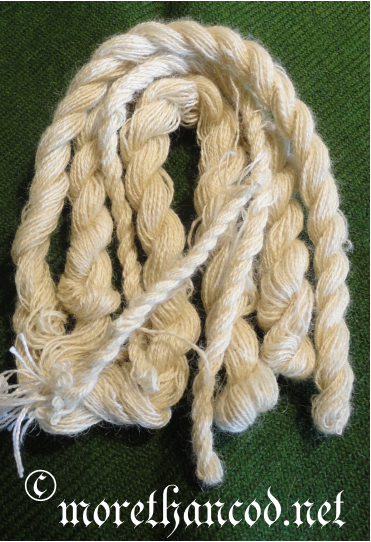Spinning into action- first threads
/The finished thread
Inspired to spin during the Tour de Fleece* on Ravelry, I’ve started with exploring spinning thread for my Golden Egg hood project, and I look forward to sewing with the results!
The Thread
This spinning effort started with 25g of Wensleydale flicked and combed** locks , in a natural white, prepared by my good friend Constanza. Flicking individual locks, like combing, helps keep the fibers ordered, and allows for the production of true worsted yarn. I wound the locks onto a hand distaff and proceeded to spin using a replica of the Coppergate 6649 spindle, image of the original can be viewed here.
The spinning took approximately 28 hours, 10 hours on each ply with an additional 8 for plying. A bit of time went to figuring out how best to work with this new spindle, and I need to develop a more efficient method for plying, but in the end I’m satisfied with the effort. Using the hand distaff is a new skill for me, and I absolutely love it!
Prepared fiber on the distaff
The end result is 25 grams of 22 WPI Z-spun/S-plied 2-ply with approximately 30° ply angle, giving 130 meters of sewing thread. It is now resting in skeins to allow the twist to relax while I prepare the next steps of this Golden Egg project.
Some historic background
Of the Norse Greenlandic finds, Østergård states “The thread for sewing is always Z-spun and then S-plied. It is spun so thin that as finished thread it is hardly a millimeter in diameter.” (p. 52). Looking in both Woven into the Earth (Østergård) and Medieval Garments Reconstructed (Frantzen, Nørgaard, and Østergård), I have not yet found specific descriptions of the angle of spinning/plying of the sewing thread, only the warp and weft of the woven fabric.
Wensleydales are not a historic breed for my purposes, but the long staple length of the hair emulates the coat length of the Old Norse sheep (Villsau) I would optimally use, and gave me experience making fine worsted thread. See also Robson & Ekarius for closer descriptions of these breeds.
*During Tour de Fleece, spinners spin fiber while cyclists spin their way around France , this year July 7-July 29.
**ETA: Constanza has informed me that these locks are flicked and comed, then drawn through a diz.
Online Resources:
Spindle: Replica of Coppergate Spindle stick 6649 with added pewter whorl weight. NiddyNoddyUK: https://www.etsy.com/uk/listing/605176484/medieval-style-low-whorl-spindle-drop?ref=shop_home_active_2
Historic spindle: http://www.mondes-normands.caen.fr/angleterre/archeo/Angleterre/wood/spindle.htm
One spindlefull, ca. 12g of fiber
Fiber: Wensleydale sheep (on Wikipedia): https://en.wikipedia.org/wiki/Wensleydale_sheep
Old Norse Sheep (Villsau) organization page (in Norwegian): http://www.villsau.no/
Constanza’s blog: https://constanzacrafts.wordpress.com/
Ravelry: www.ravelry.com
Books:
Fransen, Lilli, Anna Nørgaard and Else Østergård. Medieval Garments Reconstructed: Norse Clothing Patterns. Aarhus: Aarhus University Press, 2011. ISBN: 978-87-7934-298-9.
Robson, Deborah and Carol Ekarius. The Fleece & Fiber Sourcebook: More than 200 Fibers from Animal to Spun Yarn. North Adams, MA: Storey Publishing, 2011. ISBN: 978-1-60342-711-1.
Østergård, Else. Woven into the Earth: textiles from Norse Greenland. Aarhus: Aarhus University Press, 2004. ISBN: 87-7288-935-7.



